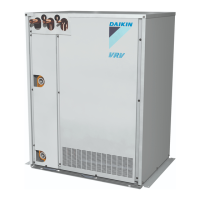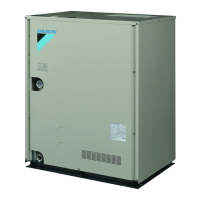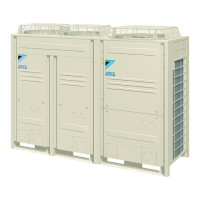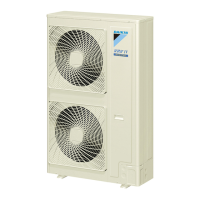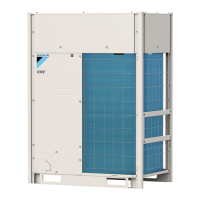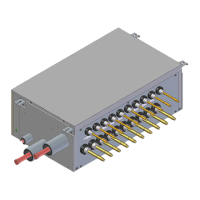5 Installation
Installation manual
24
RWEQ96~432TAYCU
VRV W T-Series water-cooled system air conditioner
4P540122-1B – 2018.11
Leak test and vacuum drying
Checking the refrigerant piping involves:
▪ Checkingforanyleakagesintherefrigerantpiping.
▪ Performingvacuumdryingtoremove allmoisture, airornitrogen
in the refrigerant piping.
If there is a possibility of moisture being present in the refrigerant
piping (for example, water may have entered the piping), first carry
out the vacuum drying procedure below until all moisture has been
removed.
All piping inside the unit has been factory tested for leaks.
Only field installed refrigerant piping needs to be checked.
Therefore, make sure that all the outside unit stop valves are firmly
closed before performing leak test or vacuum drying.
NOTE
Make sure that all (field supplied) field piping valves are
OPEN (not outside unit stop valves!) before you start leak
test and vacuuming.
For more information on the state of the valves, refer to
"5.4.3 Checking refrigerant piping: Setup" on page 24.
5.4.2 Checking refrigerant piping: General
guidelines
Connect the vacuum pump through a manifold to the service port of
all stop valves to increase efficiency (refer to "5.4.3 Checking
refrigerant piping: Setup" on page 24).
NOTE
Use a 2-stage vacuum pump with a non-return valve or a
solenoid valve that can evacuate to 500 microns or less.
NOTE
Make sure the pump oil does not flow oppositely into the
system while the pump is not working.
NOTE
Do not purge the air with refrigerants. Use a vacuum pump
to evacuate the installation.
5.4.3 Checking refrigerant piping: Setup
p
<
p
>
R410AN2
C
(1)
D
b c e
a
g
h
f
d
A B
a Pressure reducing valve
b Nitrogen
c Weighing scales
d Refrigerant R410A tank (siphon system)
e Vacuum pump
f Liquidlinestopvalve
g Gas line stop valve
h High pressure/low pressure gas line stop valve
A Valve A
B Valve B
C Valve C
(1)
D Valve D
(1) Only for heat recovery mode.
NOTE
Do not connect the vacuum pump to the suction gas stop
valve if the unit is intended to run in heat pump mode. This
will increase the risk of unit failure.
Valve State of valve
Valve A Open
Valve B Open
Valve C Open
Valve D Open
Liquidlinestopvalve Close
Gas line stop valve Close
High pressure/low pressure gas
line stop valve
Close
NOTE
The connections to the indoor units and all indoor units
should also be leak and vacuum tested. Keep any possible
(field supplied) field piping valves open as well.
Refer to the indoor unit installation manual for more details.
Leak test and vacuum drying should be done before the
power supply is set to the unit. If not, see also the flow
chart earlier described in this chapter (see "5.4.1 About
checking the refrigerant piping" on page 23).
5.4.4 Air tight test and vacuum drying
▪ After finished piping work, carry out air tight test and vacuum
drying.
NOTE
▪ Alwaysusenitrogengasfortheairtightnesstest.
▪ Absolutely do not open the stop valve until the main
power circuit insulation measurement has been
completed. (Measuring after the stop valve is opened
will cause the insulation value to drop.)
<Needed tools>
Gauge manifold
Charge hose
valve
▪ To prevent entry of any impurities and insure
sufficient pressure resistance, always use the
special tools dedicated for R410A.
▪ Use charge hose that have pushing stick for
connecting to service port of stop valves or
refrigerant charge port.
Vacuum pump
▪ The vacuum pump for vacuum drying should
be able to lower the pressure to 500 microns.
▪ Take care the pump oil never flow backward
into the refrigerant pipe during the pump stops.
NOTE
▪ The air-tightness test and vacuum drying should be
done using the service ports of suction gas pipe, high/
low pressure gas pipe and liquid pipe stop valve. See
the [R410A] Label attached to the front panel of the
outside unit for details on the location of the service
port.
▪ See"5.6.4Tochargerefrigerant"onpage28 for details
on handling the stop valve.
▪ The refrigerant charge port is connected to unit pipe.
When shipped, the unit contains the refrigerant, so use
caution when attaching the charge hose.
<Air tight test>
Pressurize the suction gas pipe, high/low pressure gas pipe and
liquid pipe from the service ports of each stop valve to 550 psi (3.8
MPa) (do not pressurize more than 550 psi (3.8 MPa)). If the
pressure does not drop within 24 hours, the system passes the test.
If there is a pressure drop, check for leaks, make repairs and
perform the air tight test again.
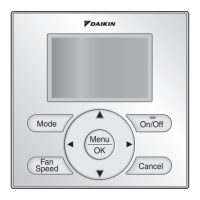
